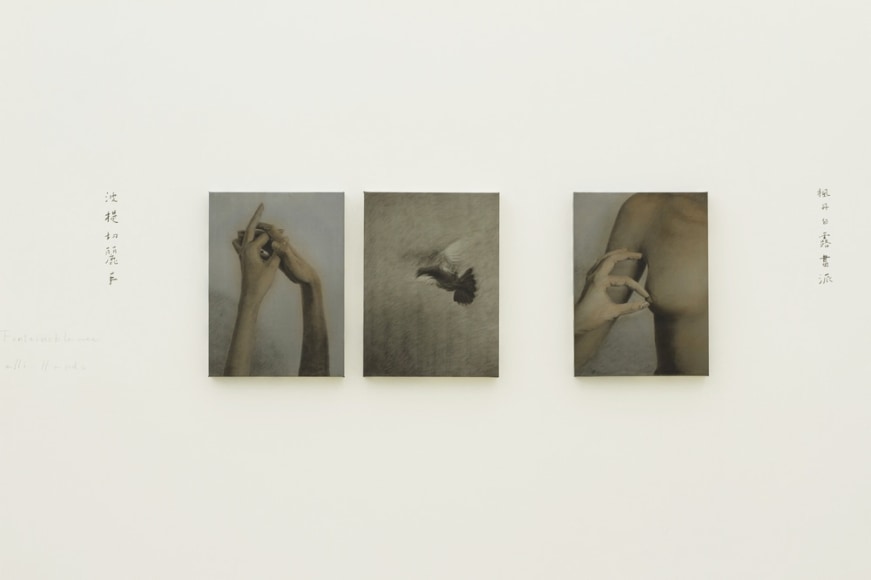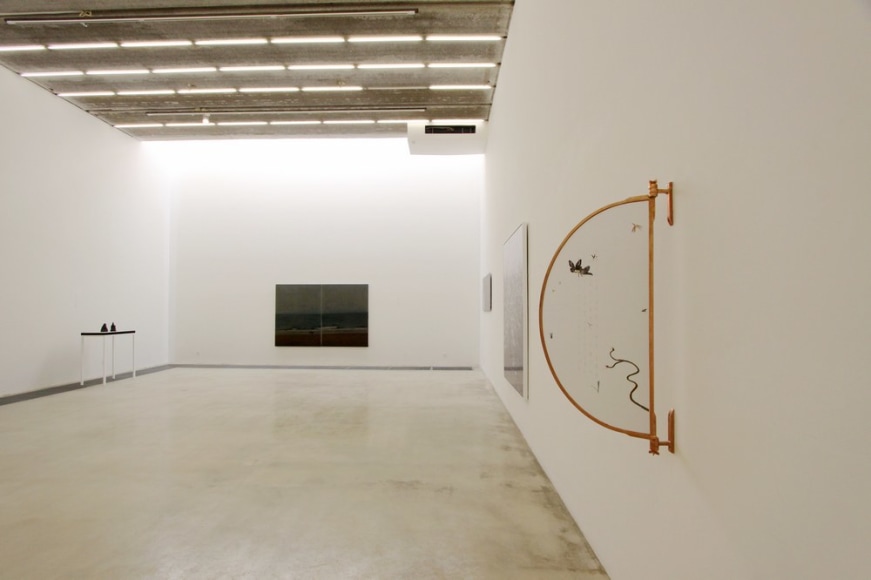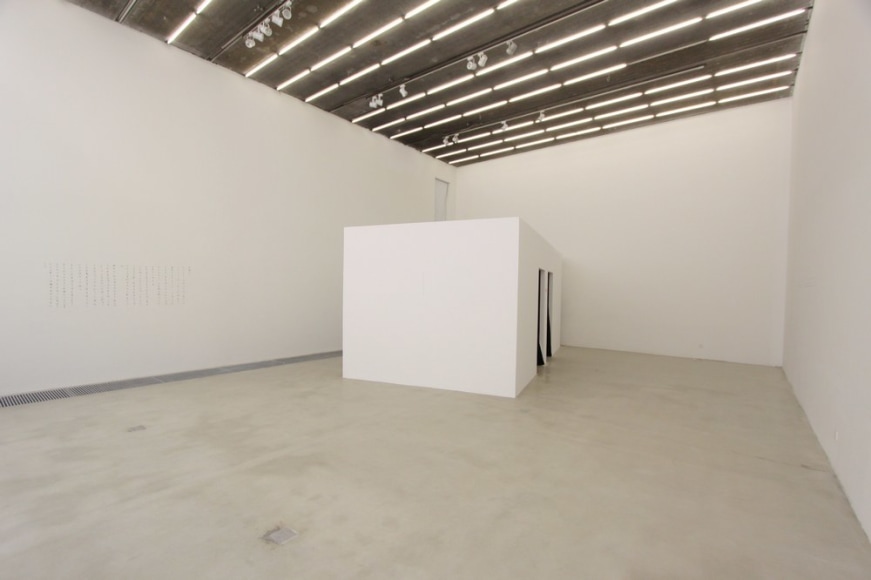Chambers Fine Art is pleased to announce the opening on February 18, 2012 of Mi Lou: Recent Works by Hong Lei. In each of his exhibitions at the gallery since 2003, Hong Lei has extended the range of media in which he works to include not only photography, the medium in which he first gained fame in the mid-1990s, but also painting, sculpture and installation. This broadening of the range of his activities was necessitated by the diversityof his thematic concerns which however contemporary they might appear to be are always deeply rooted in a deep appreciation for the great cultural and artistic achievements of China’s past.
For the current exhibition he has turned to Mi Lou, the legendary architectural folly of Emperor Yangdi (604-618), the last emperor of the short-lived Sui Dynasty (604-618). On one hand Yangdi was an aggressive warrior whose campaigns in what is now Korea and Vietnam left his empire bankrupt. On the other he was a visionary who promoted the construction of the great canal between Beijing and Hangzhou which transformed the face of China anda dreamer who late in built Mi Lou (Labyrinth Tower) in the southern capital of Yangzhou. Built solely for the entertainment of Yangdi and his concubines and where eventually he was murdered, this vertical labyrinth has become synonymous with the extravagance and decadence that characterized his reign.
A connoisseur of such legends, Hong Lei has created an installation that emphasizes the hold that they still have over our imagination. As so often in his work, it is in the contrast between lightness and dark, day and night,historical fact and fiction or legend, that profound truths can be glimpsed. Brilliantly lit and lacking in mystery, Hong Lei’s three-dimensional reconstruction of Mi Lou suspended from the ceiling only gains emotionaltruth when seen the right way up in the adjacent darkened room, conveyed through the minute opening of the pin-hole camera (camera obscura) in the center of the wall that separates the two rooms.
In the adjacent gallery, Hong Lei explores related issues in a series of individual works that refer indirectly to the cultivated sensuality associated with the legendary Mi Lou and comments on the gulf separating it from China in the twenty-first century. A fascination with refined eroticism and sexual ambiguity evident in Kingfisher, After Fontainebleau and Botticelli- Hands contrasts with the landscape motifs of Tilted Ocean, Blossoming Pear Tree- Sadness, Tilted Ocean and March-He Yuan, Yangzhou. As always in Hong Lei’s work, however, apparent placidity in theme is generally the occasion for deeply ironic and melancholy reflection as, for example, in the photograph of the celebrated garden in Yangzhou in which the tourists trudging through it are oblivious to the spiritual vision of its creator or the classically romantic view of the ocean frequented by dogs rather than lovers.
Among artists of his generation, Hong Lei is distinctive for the persistence with which he pursues his poetic vision, deeply attached to Changzhou in Jiangsu province where he was born in 1960 and where he still lives. A thoroughly modern version of the earlier literati who did so much to shape Chinese civilization, he looks beneath the surface of today’s world to find mysterious reverberations, ghostly suggestions of a sublimity that once existed but can only be glimpsed today.
北京前波画廊非常荣幸地宣布将于2月18日起举办洪磊近作展《迷楼》。自2003年以来,在前波画廊的每次展览中,洪磊都一直不断地拓展作品的媒介范围,这次不仅包括他于九十年代中期开始受到关注的摄影风格外,还将其表现形式延伸到刺绣,雕塑和装置等。同时,这些形式上的拓展也离不开艺术家广泛的作品主题,即使利用了当代的表现手段,其作品往往还是基于对中国古代文化的热爱和他的艺术成就。
此次展览中,他把主题转向隋炀帝(公元604年至618年)所建的宫殿“迷楼”。隋炀帝是隋朝(公元581年至618年)的末代皇帝,在位时一方面是好战的勇士,在对高句丽、吐谷浑和突厥发动的战争中使国家造成了巨大的耗损。而另一方面,他又富有远见,修建了北京到杭州的运河,从而完全改变了中国的面貌。隋炀帝也是一个梦想家,晚期在江都(今扬州)建造了宫殿“迷楼”,供其及宫妾们恣意享乐,他最终也是在这里被谋害了。于是,这座直立的迷宫最终成为他统治时期的铺张浪费和颓靡生活的代名词。
通晓此类传奇的洪磊通过其创作的装置肯定了这些故事依然吸引着我们。就如可以在他的作品中看到的,艺术家通过明亮与黑暗、白天与黑夜、历史事实与传说等之间的对比来表现出深刻的事实。洪磊此次创作的悬浮三维装置《迷楼》在强烈的荧光灯照射下毫无神秘感,只有当艺术家利用针孔成像的原理将其反射在隔壁漆黑的房间里后,才体现出作品的感性化和真实感。
在另一间展厅,洪磊则通过一系列独立的作品来探索相关的题材,有些与迷楼的情欲生活有着非直接的联系,而另一些则是对迷楼和21世纪中国之间的巨大区别的评论。作品《翠鸟》、《枫丹白露画派》及《波提切利的手》中体现的对雅致情色的迷恋与以风景为主题的《倾斜的大海》、《一树梨花的伤春》及《三月的片石山方》形成了对比。而洪磊的作品中,相对平静的主题却往往带有着讽刺意味或是反映了深深的忧郁,例如,在扬州著名花园的摄影作品中,跋涉参观的人群丝毫没有察觉到创造者赋予园林的精神体验,而占据经典的浪漫海景则是狗而非情侣。
艺术家于1960年出生于江苏省常州市,至今仍在那里工作和生活。在他同辈的艺术家中,洪磊以其富有诗意的独特创作眼光而受到关注。古代的文人学士塑造了中国文明,而洪磊则是一个现代版的文士。他通过揭露当今世界表象来挖掘其背后隐藏的神秘,揭示那些曾经存在而今天只能偶尔窥视到的气质和美感。




